
Among many things that Pakistan has been blessed with, the quality of fruit is an important one. Especially worth mentioning is the Pakistani pomegranate. It is hard to find a rival of it in size, flavor and color. I’ve collected few photos of pomegranates and its juice for sale in Pakistan here. Take a look and be a part of this famous urdu idiom: ‘ek anaar, sau beemaar’ (one pomegranate can make a hundred people devoted to it)
I chose following two photos because of their color. The yearning of savouring the taste of an ice cold pomegranate as shown in these photo is hard to resist. Those who have tasted a pomegranate like such will join me in saying that ‘ek baar khaya hai, aur dobara khaane ki hawwis hai’ ( have eaten once and yearning again)
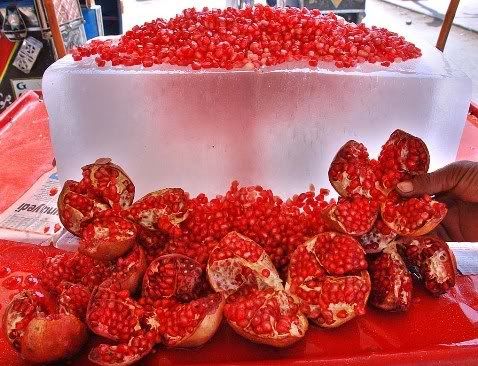
It is said that best variety of pomegranate in Pakistan is called Kandahari anaar, and is imported from our Western neighbor. It is also grown in Pakistan – mostly in Balochistan. In 2007, Pakistan exported more than 4500 tonnes of Kandahari anaar from Pakistan. On the origin on pomegranate tree itself, it is said that Pomegranate came to Pakistan from Iran, where it was a native plant specie.
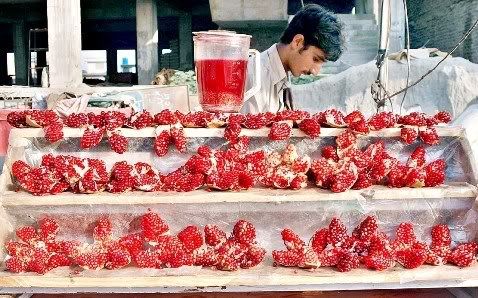
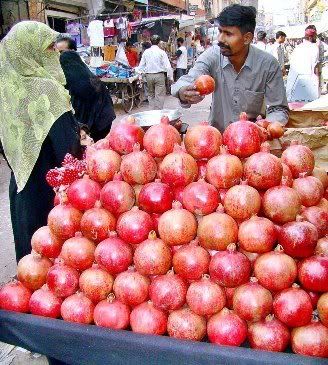 The photo to the right is from Tower Market Road, Hyderabad. Note the size of pomegranates in this photo. These are one jumbo pomegranates.
The photo to the right is from Tower Market Road, Hyderabad. Note the size of pomegranates in this photo. These are one jumbo pomegranates.
Pomegranate is not only a part of Pakistan’s important fruit species, but over the years it has also influenced on art, literature, language and poetry. When a person has healthy beautiful cheeks, they are compared to a pomegranate.
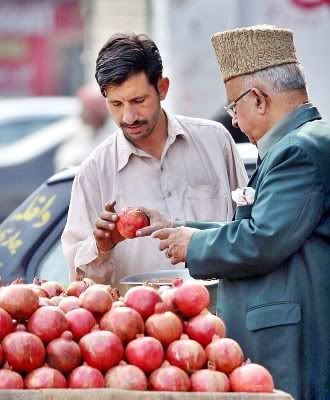 The photo to the left is from Rawalpindi and it shows an old timer choosing a pomegranate at the vendor thela(cart).
The photo to the left is from Rawalpindi and it shows an old timer choosing a pomegranate at the vendor thela(cart).
Flower bud of a pomegrante is called ‘anar kali’ and one of the most famous movie character coming out of India-Pakistan’s was named Anarkali.
The dried seeds of pomegranate called ‘anar daana’ are extensively used across Pakistan to bring a bit of sour taste to the food.
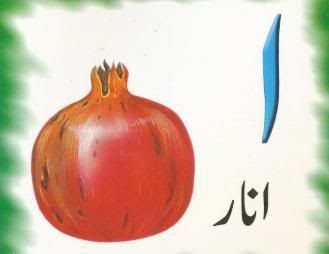 And since I am writing this post without putting much thought to the order of essay and only concentrating on something in praise of a Pakistani anaar therefore the next thought that comes to my mind in support of a Pakistani anaar is how every Urdu book starts with the first alphabet as ‘alif se anaar’. Look to the image to the right. bus ab aur kia likhooN anaar ki tareef meiN
And since I am writing this post without putting much thought to the order of essay and only concentrating on something in praise of a Pakistani anaar therefore the next thought that comes to my mind in support of a Pakistani anaar is how every Urdu book starts with the first alphabet as ‘alif se anaar’. Look to the image to the right. bus ab aur kia likhooN anaar ki tareef meiN
Quetta ka anaar:
Here is atleast one sher in Urdu which makes use of ‘anaar’. Enjoy this ghazal by Anwar Masood and keep an ear open for the sher with the words ‘Quetta ka anaar’. This ghazal as most of our readers may already know is a parody of a famous ghazal by Momin Khan Momin.



















































Another mouth-watering post! Thanks Owais!
Being a life-long “Anar” votary, I’ve learned to live with the
shrivelled variety that is avilable locally, a far cry from
those luscious red pyramids pictured in your article.
“So anars” and not a single one for me! Alas!
(I am glad that somebody else has already posted the correct
translation of “Ek Anar, i.e., “one Pome and one hundred
patients.”)
I only need to point out that “Anarkali,” is not a movie char-
acter, but the title character in Imtiaz Ali Taj’s famous
play of the same name, which was based upon the legends
about Prince Saleem(who later became the Emperor Jehangir)’s supposed star-crossed love-affair with a
dancing girl Anar Kali(which might not have been her real
name but rather a title which, according to the legend,
Emperor Akbar had bestowed upon her.)
And yes, Pomegranate and the Blue Berry juice is the latest
American fad among the health-conscious crowd.
Haq Bhahi, for the first time I have some doubts about
your statistics. Are you sure? My impression is that Pakistanis habitually eat more fruit than Americans.
Pakistanis have a very good habit of eating fruit as dessert
It ‘d be very hard for an average American to wrap his/her
mind around that concept! You see the acute sugar shortage
in Pakistan might actually be a blessing in disguise.
well these are kandhari anar, because the species originated or was native to Kandahar. That does not mean our kandahari anar do not come from quetta valley.
However another common pomegranate type I saw across Pakistan was the whitish one … not bad.
Our fruits and vegetables are definitely something special. I have never come across a ‘sufed khobani’ or the ‘sundarkhani angoor’ in Europe or America at all. Not to mention that the mangoes you find over here are abysmal compared to those from Pakistan.
Some comments from the ATP Facebook Page:
– “best part of winter :D”
– “isb main to 60/kg hain/…..:D”
– “I like it I like it………!!!!!!!!!!!!
Really a true pomegranate carrying a true colour of Love”
– “the second picture with pomegranates on an ice slab is deliciously lovely.”
– “Pomegranate juice with a little black pepper and salt. Yummmm!”
– “i love pomegranete with salt & black pepper yum yum”
– “Pakistani fruit is top of the pops in the world”
– “When we were @Euro to find a true pomegranate, U need to wait for ages. In Fruits & Vegetables -Yeah we are like blessed forever in Pak. U only knw it whn u dont hav it, Check out market of Gulf or Euro to compare with our fruits. U won’t find a True Mango or a True pomegranate in All Europe..Cheers . Txs for SharinG, AH!!”
– “not Europe but almost: look for Anar in Turkey! Overwhelming Anar stands there, sour and sweet ones as well as fresh pressed juices at almost every corner if you go around March/April”
– “they look tempting but i prefer the Afghani ones as they have that sour taste that i love.”
– “O kia anaar bhi afghani hotay hain? :P i dint know veges had bounds too.”
I dont think these faboulous Pommegranates are a Pakistani product, ans are most probaly from Kandhar, provnce of afghanistan as their name uggests ‘ KLandhari anar’. Howeever i mabe be mistaken and same might be a produce of Quetta valley. Any comments?
Owais:
Great Post and very timely too as the Anaar Season is just starting.
In a recent visit to the US I found Super Markets selling bottled Anaar Juice. Something recent I think. Probably they are growing them in California that has a large Iranian population and the climate is right.
A new fad after Youghart!